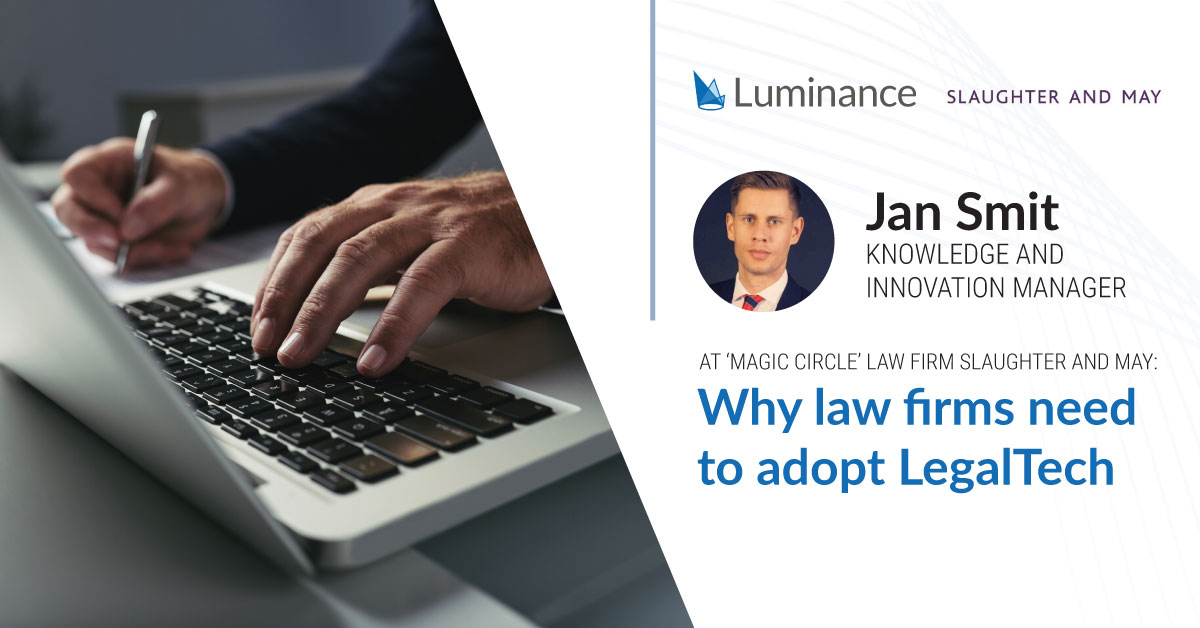
Blog
Jan Smit, Knowledge and Innovation Manager at ‘Magic Circle’ law firm Slaughter and May: Why law firms need to adopt LegalTech
14 April 2020 | Luminance
Technology is reshaping the legal industry, with more and more law firms embracing productivity-increasing tools to sustain a competitive advantage in a fast-moving and uncertain legal landscape. The application of machine learning to the legal process is the ultimate tool to gain unparalleled insight into vast troves of legal documents at a speed that far surpasses human capacity. Magic Circle law firm, Slaughter and May, is renowned as a leader of innovative services, having first tested and helped develop Luminance, the leading AI tool for lawyers. We speak to Jan Smit, the firm’s Knowledge and Innovation Manager about why he thinks legal technology should be an integral part of law firms’ practices and business models:
1. Client demand
Law firms are expected to keep up with client expectations and demand which, like the legal landscape, is constantly changing. Clients are looking for a stellar service, with a quick turnaround, at a reasonable cost. Implementing legal technology is key to achieve this. Jan Smit comments, “The legal landscape has changed so much in the last few years. Lawyers are under constant pressure to keep costs reasonable and to deliver legal services in new and innovative ways.”
By using technology like Luminance, law firms can redirect resources to higher value tasks, evolving the services they provide. Luminance enables lawyers to start their review with a greater level of insight than is typically possible after weeks using traditional methods, resulting in significant time savings on day one of use, and increasing exponentially as the advisor continues to interact with the platform.
“We are now increasingly asked by our clients ‘which legal technologies are you going to use on our matters?’”, Jan adds.
2. Attract the best talent
Earlier this year, it was announced that Slaughter and May kept 29 out of 31 trainees, representing a trainee retention rate of 94%. Whilst document review will no doubt always be part of a trainee lawyer’s life, software like Luminance means that Slaughter and May’s junior lawyers will not just be wading through repetitive contract analysis, but will be able to apply and hone their newly acquired legal skills and knowledge, helping to retain the lawyers they have invested time into training.
Jan emphasises how important this is in attracting the best young legal talent: “If you are applying for a training contract and you’ve got offers from multiple top-tier firms, how do you decide which offer to accept?” This is where technology can set firms apart: “We need to we have the right legal tech resources in place to show prospective trainees we are an innovative firm that cares about the way they work. If we don’t have these resources in place, we might lose that talent…they might go to another firm where these already exist.”
By operating as a seamless extension of a lawyer’s review process, Luminance’s ground-breaking machine learning technology allows lawyers to get to the crux of the deal with unparalleled speed and insight. Importantly, this means that lawyers get to focus on the tasks they have been extensively trained to do: provide high level analysis and counsel to their clients.
3. Gain a full understanding of your dataset
Trawling through hundreds or thousands of documents is no longer feasible for the modern-day lawyer. Jan notes: “In the past, lawyers would sit in a room with boxes of hard copies of documents. Whilst the digitalisation of documents made things easier, advisors still had to spend lots of time scrolling through hundreds of documents to identify clauses.”
Luminance’s core intelligence, ‘LITE’ (Legal Inference Transformation Engine), applies a pioneering blend of supervised and unsupervised machine learning to read and analyse contracts, without prior training or configuration. As well as significantly reducing the time spent on ‘sampling’ exercises, Luminance’s technology provides lawyers with an all-encompassing oversight into a document room, putting lawyers at the forefront of their review, and the negotiation.
“All of a sudden, lawyers have a complete overview of documents - without anyone even having to touch the system”, Jan notes.
The future of tech
Technology is rapidly evolving. Incorporating machine learning into legal workflow is increasingly being recognised as being business and client-savvy. The application of AI to legal workflows allows lawyers to deliver faster, more insightful and more effective legal advice to their clients.